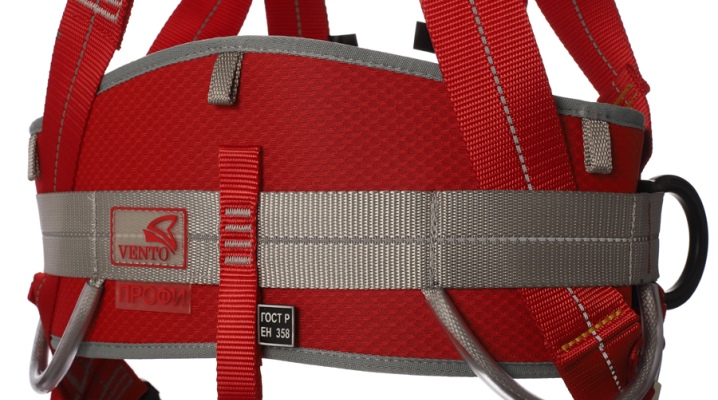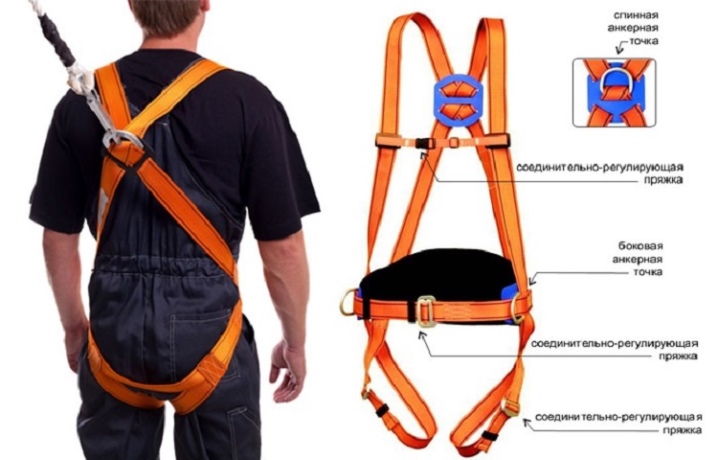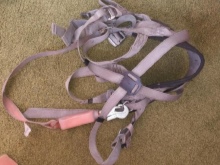What is a full body harness and how to use it?

According to the labor protection law, an employee performing his duties at a certain height is required to use a safety harness to protect him from falling. High-altitude work is associated with a risk to the health and life of the employee, therefore, the requirements for safety devices are high. The choice of equipment depends on the complexity of the job and the height. Let's figure out what a harness is and how to use it.


What it is?
A full body harness is a personal safety device for working at height. The device is a structure of strong slings, fixing buckles and locking elements. The tightness of the girth of the lines can be adjusted, which gives complete confidence in the firm hold of the worker, excluding the possibility of his falling from a height. The safety harness is used not only for high-altitude work, it is used in emergency situations, when filling large containers with combustible products, for work in narrow and deep wells, as well as for mountaineering.


When working at height, it is important to be aware that a harness alone is not a guarantee of safety.
Only in combination with the high qualifications and skill of the worker can this system become a reliable fall protection system. High-rise work is considered to be the performance of functions at a height of more than 1.8 m from the floor level or the surface of the earth. These include installation and roofing work related to lifting and lowering, as well as work performed at a height of more than 5 meters in the absence of additional supports.


Primary requirements
The main task performed by the safety system is to stop the worker's body at the moment of falling from a height, as well as to prevent an unexpected sudden descent down. The requirements for belay devices are as follows.
- An understandable and convenient use of an individual safety system, where the worker adjusts the dimensions for himself independently, is able to provide not only quick preparation for the start of work, but also helps to quickly navigate in the event of any emergency situation.
- The harness must be made of a durable and lightweight material that has been pre-tested and can support several times the weight of a person.

In order for the harness to provide reliable protection during work, before putting on the safety system on yourself, you need to carefully inspect it and check it for integrity. Each belt must be labeled with the size, date, and system strength test number.
Manufacturers of belay systems put a stamp on their products, confirming the readiness of the belay system for work and the date of its manufacture.

Species overview
Each full body harness has its own factory marking and a detailed description of the operation. Depending on the complexity of the model, the equipment consists of certain components.
- Shoulder straps - located on the shoulders, covering the chest and back, firmly attached to a wide belt.

- Leg straps - clasp the legs in the hip area, most often they have special pads that allow you to work more comfortably. Not all harnesses are available with leg straps, they are provided for mountaineering equipment.

- Rear rods Is a sling system that connects the leg and shoulder straps.

- To support the back and to reduce fatigue, a belt with a wide sash is used, to which metal rings are attached for fastening. Most often, belts with two rings are used, which make it possible to work simultaneously with two carabiners.

- Self-locking buckles - are needed so that a sudden unfastening or relaxation of the waist belt does not happen, in addition, the buckles make it possible to change the length of the shoulder or leg straps.

Safety harnesses differ in the purpose of their use. - it can be protection against an unexpected fall, which is performed using a shock absorber, and there is also equipment that allows the employee to carry out work for a long time in a sitting position at a high altitude. According to its design, associated with the number of body fixation points, the harness is subdivided into the following options.


Single point
A single point harness restraint harness is a slider type structure consisting of a full body harness, slider, shock absorber and anchor linear mechanism. With this type of attachment, the fall arrest system moves along the anchor line, following the movements of the person. In the event of a sudden fall, the system automatically locks in and stops the movement process.

The harness attachment point is on your back or chest. Hip and shoulder straps are not provided in this case. This type of belay device is used when climbing stairs to a certain point in height, to perform roofing work at low heights, as well as to work with surfaces that have a small angle of inclination.

Point-to-point
This is a more reliable type of safety restraint harness, which makes it possible to fasten any type of structure that serves to stop the process of a sharp fall down - for this purpose, slings with a shock-absorbing system, individual retracting-type means, slider-type clamps, and so on are used.
Attachments are made to two points of the harness, located on the back and chest.
The harnesses always have shoulder straps and straps to wrap around the legs.

Three-point
The restraint harness has three sling attachment elements. There are two types of three-point harness. In one case, the fasteners are a belt and shoulder elements with fastening elements located on the belt. In the second case, the harness is designed for arboristics and looks like a belt with hip straps. Both types of harness have the function of limiting the movement of the worker, protecting him from the risk of falling from a height. The harness is used in conjunction with an anchor system, which provides a stop during a fall.

Four-point
This type of construction is referred to as a full body harness. The four-point design can be either with one element for attaching the sling, or with two such elements. The design has shoulder and hip straps, on the back and on the chest there is a fastener for a belay line and restraint from falling. In a design with two attachment elements, a sling attachment element is provided, which consists of two additional loops.

Five-point
This is the safest version of a safety harness used to belay an employee from a fall from a great height.
The design of the harness has 5 attachment elements for the lines.
It includes a belt, shoulder and hip straps, there are 2 attachment elements for the sling for belaying and holding, as well as an attachment element for the sling, designed for the device for lifting and lowering purposes. Five-point equipment is used for a narrow segment of work in the field of industrial mountaineering.

Selection Tips
It is necessary to pay attention to a number of important indicators in the work of the safety system, which ensure the reliable and correct position of the body of a person performing any work at height. When choosing the type and size of the harness, you need to consider the following.
- When determining the size of the harness, it is important to remember that with the buckles fastened, at least another 10 cm of free web of the lines should remain in stock.
- Any industrial safety equipment must be made in compliance with GOST. As for the models intended for industrial mountaineering, they must be provided with a special UIAA mark or the abbreviation EN.
- The harness must work simply and reliably so that the person does not feel uncomfortable and can work for a long time in a comfortable body position.



Safety devices are selected based on the degree of complexity of the work tasks. A harness that performs belay functions meets safety requirements in the following cases:
- the material, made of high quality polyamide, can withstand a weight several times that of a person;
- the whole system is clear and simple for the user;
- the finished harness is lightweight;
- the size of the equipment corresponds to the height and size of the person who will use it;
- shoulder straps should be at such a distance from each other that will allow them to prevent neck injuries, while not falling off the shoulders and not overlapping with each other;
- each buckle must be in good condition and have a self-locking function to avoid unbuckling the equipment during work.
Such requirements are GOST standards and must be met without fail.
Every fall arrest system must be duly tested for serviceability.



How are the tests carried out?
According to the new rules, from 2015, all fall protection equipment must be certified for compliance with the requirements of the technical regulations of the Customs Union. The procedure for examination for the degree of wear and inspection for defects is performed by a specially trained employee authorized by the employer., having III group of safety clearance or a convened labor protection commission. The frequency of inspection is carried out at least once every 12 months, but an authorized person or commission has the right to carry out more regular inspections, the need for which is caused by the intensive use of safety equipment. A full body harness can be exposed to the risk of melting (welding), chemical destruction (when handling harsh chemicals), as well as abrasion of lines or breakage of fasteners during operation.

Safety equipment check includes:
- visual and tactile examination for the functionality of personal protective equipment;
- external examination of anchor devices to identify mechanical failures and damage, corrosion and deformation of metal parts;
- the presence of factory markings and the shelf life of products for use.
There are certain expiration dates for protective equipment.
The equipment can be used no more than 5 years from the date of its manufacture.

As for the ropes made of synthetic materials, their service life is much shorter and is no more than 2 years or no more than 400 hours of intensive working use. If during the inspection of protective equipment any defect is found, then such protective equipment is written off and is no longer used for operation.

Operating rules
In addition to the expiration date, the authorized person inspecting the personal protective equipment must inform the employee about the rules for using the safety equipment. To do this, you should study the instructions for use, which are supplied with all factory-made products. In order to use the harness correctly and not to disable it before the warranty period of service, you should know and do the following:
- before starting work, the equipment must be put on and tightened the belts of the belt, as well as the leg straps;
- adjust the height of the attachment point on the back while adjusting the shoulder straps;
- connect the shoulder straps with the belt using the carabiners intended for this;
- in the presence of a shock-absorbing connecting system, it must be secured with a leash to the anchor device.

An important factor for performing work at high altitude is taking into account negative factorsaffecting the state of the equipment - these may be inconsistencies in temperature regimes with those stated by the manufacturer for his product.
What is a full body harness, see below.












The comment was sent successfully.